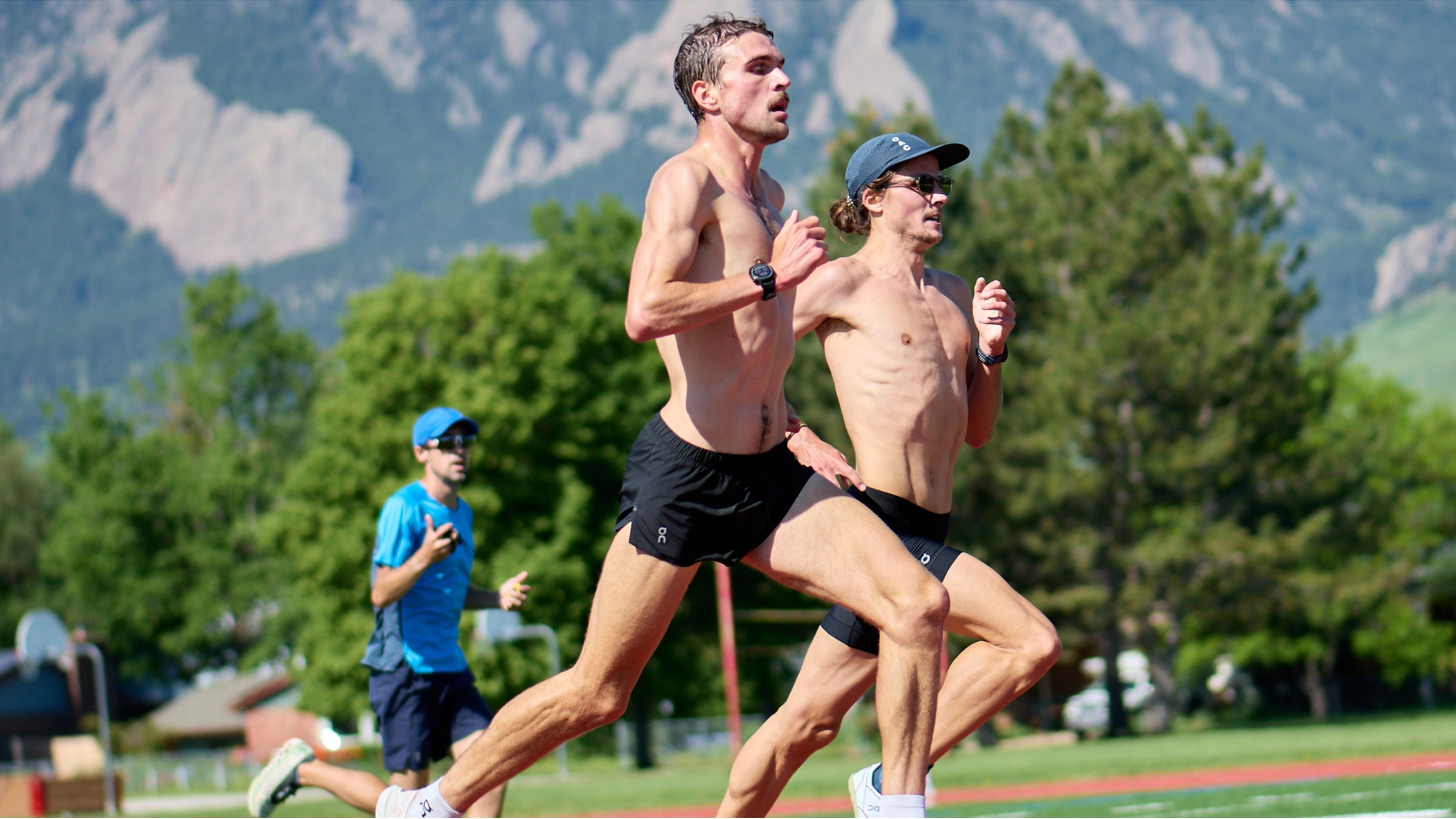Less than a year after Ollie Hoare and Joe Klecker became the first runners to break the 4-minute mile barrier on Colorado soil as part of the low-key, but eye-popping initial race effort of the On Athletics Club, the Dathan Ritzenhein-coached team is poised to have at least two, and possibly several more, runners heading to next month’s Tokyo Olympics.
Looking for inspiration as U.S. Olympic Trials and Olympics approach, look at what the has accomplished in the past year. Yes, the past year when the world was locked down from the Covid-19 pandemic, the entire 2020 track season was canceled and a lot of the sport, business and energy of competitive running went dark.
It was only 12 months ago that Klecker and Hoare joined the professional ranks as he became the first athletes signed to the newly formed training group based in Boulder, Colorado. With those two leading the way, the fledgling eight-member team sponsored by , has started to make a name for itself with a cast of talented but mostly unseasoned runners.
However, simply turning pro and getting paid to run isn’t what has helped them elevate their game so much. The secret sauce has been the inspiring chemistry and bond the crew forged through hard work, consistent training and the guidance of Ritzenhein amid all of the stresses and unknowns of the crazy year that was.
“Yeah, it was a crazy year, but, really, everything has gone exactly according to plan up to this point,” the 24-year-old Klecker says. “This is right where we wanted to be. But honestly, a year ago, I never would have thought that I would have had a chance to make the Olympic team. We’re here now because of what we’ve all done in the past year.”
The path to success in professional running is sublimely simple: be earnest, consistent and relentless about doing the work and mind the little things so you can actualize your potential and maximize your performance. But it’s also infinitely complex: knowing how to push your body to extreme limits without breaking it, being physically tuned enough (and rested enough) to put yourself in position to excel and then having the mental acuity and physical ability to push through temporarily hard and painful moments to achieve success.
Distance running carries with it an odd paradox: it’s really not a team sport and more individually focused, but it’s extremely hard to attain individual success at any level without being part of a cohesive and supportive team. In other words, even though it requires intense individual commitment and effort, it’s almost impossible to do it alone.
As such, the by Ritzenhein and On’s global sports marketing team for their athletic prowess and future upside, but also for their personality and willingness to buy into the bigger team dynamics, willingness to work and letting their results speak for themselves. Look-at-me social media posts are not part of the equation.
The Impressive On Line Up
So far, their results speak volumes. Hoare, also 24, is a former University of Wisconsin star who has been on a tear since joining the OAC. He’s ranked No. 9 in the world and No. 2 in his country in the 1,500m (3:32.35) and figures to have a place on the Australian Olympic team, even though he missed the qualifying meet in his homeland because Covid-19 restrictions would have forced him to quarantine in a hotel without any ability to run (even on a treadmill) if he had traveled back. (The final Australian team will be announced on July 1.)
Klecker, meanwhile, is No. 13 in the world, third among Americans, in the 5,000m (13:06.67), and 20th in the world and fifth in the U.S. in the 10,000m (27:23.44) — a legitimate contender to finish in the top three in each event at the June 18-27 U.S. Olympic Trials in Eugene, Oregon.
Former Michigan State standout Leah Falland, who Ritzenhein had been coaching for two years prior to the OAC, has rejuvenated her career at 28 and is fifth among Americans in the 3,000-meter steeplechase (9:28.72) heading into the U.S. trials. Alicja Konieczek is ranked No. 1 in her native Poland in that event (9:33.42) and is expected to make the Polish Olympic team.
Alicia Monson, (U.S., 5,000m, 15:07.65), Carlos Villareal (24, Mexico, 1500m, 3:40.40), Geordie Beamish (New Zealand, 1,500m, 3:37.57) and Emily Oren (U.S., 3,000m steeplechase, 9:41.92) have all set new personal bests and have emerged to challenge for a spot on their respective country’s national teams.
“We wouldn’t be where we are now without the team,” Klecker says. “Definitely getting people to work together is the No. 1 thing. I didn’t always know how big of a deal that would be a the pro level, but just seeing it first hand with our team and knowing how well we work together, it just shows in our performance how much we have elevated each other.”
It’s been an impressive start so far, and it’s happened quicker many people expected.
“Yeah, we came out of the gate strong,” Ritzenhein said. “But a lot of things kind of came together at the right time with the right people to make it all happen.”
Here are five key reasons why the team has excelled, with takeaway points for committed runners at any level:
1) Vision and leadership
During his 20-year career as an elite runner, no one questioned Ritzenhein’s determination or resolve. Aside from his obvious talent, it was his relentlessness that helped make him a three-time U.S. Olympian and 2:07 marathoner. But his quick transition into an elite coach and managing the many moving parts and unique stresses that has come with it has been rather remarkable. Although he had already started coaching part-time over the previous five or six years, he was still training as an elite marathoner with the hopes of running in the 2020 U.S. Olympic Trials Marathon before an injury sidelined him.
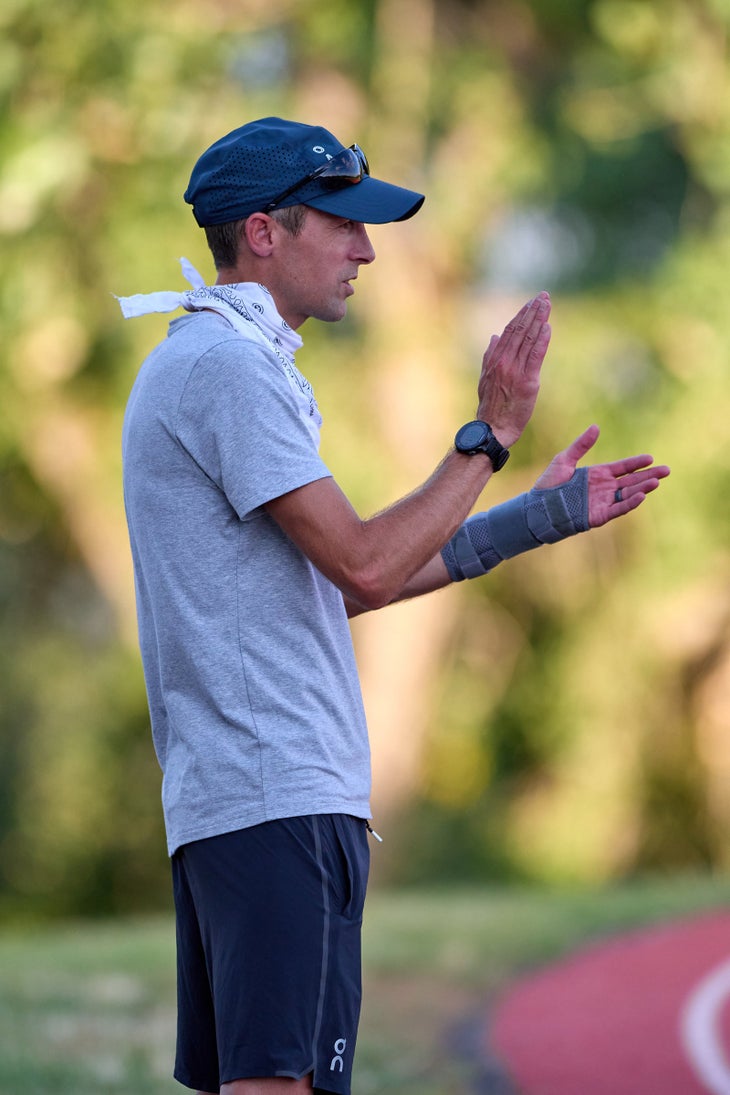
When DeKoker made Ritzenhein an offer to start a new elite team last April — just after DeKoker started with the company and just as the Covid-19 pandemic ended the 2020 track and marathon season — Ritzenhein jumped at the opportunity. He announced his retirement as a runner, setting his sights on Klecker as the team’s initial athlete while also preparing his family to move to Boulder, where he previously earned NCAA individual and team championships at the University of Colorado.
DeKoker and Ritzenhein had become friends when DeKoker was at Brooks Sports and brought Ritzenhein into the Brooks Hansons program in 2017 for the final three years of his running career after he returned home to Michigan. Ritzenhein’s pedigree and experience commanded immediate respect, but it’s how he’s managed the OAC team and guided the athletes that has really earned their trust.
“As an athlete, he was a detail guy and was always all-in on everything, but I didn’t realize it was going to transition so well and so quickly,” DeKoker says. “He’s doing all the things that you hope a coach would do – being at all of the workouts and having individual plans for everyone and having a unique relationship with each of his athletes. He travels with the team, rents and drives vans and does all of the little things that, maybe with his résumé, you wouldn’t necessarily expect.”
“There are a lot of pro athletes who transition into coaching, and often it’s an option for them to stay in the sport,” DeKoker adds. “In Dathan’s case, he was a really good runner but his experience was almost setting him up to be an even better coach. He was just born to do this.”
2) Inspiring chemistry
That the On Athletic Club has produced some fast times in its first year isn’t a surprise. With eight talented runners, the support of On and Ritzenhein at the helm, it might have been a no-brainer to predict some level of initial success. But for all eight runners to have made big strides in such a short time, despite many individual and collected stresses, is at least partially due to the team chemistry and symbiotic atmosphere that has been fostered by everyone involved. Having runners from several countries was always a key initiative, for marketing purposes and global reach, but also to create a unique team culture.
“This feels different because it feels like a team,” Ritzenhein says. “During my running career, I wasn’t really part of a team very much. Training groups and training partners are awesome, and that’s what I had, but all of our OAC runners have a vested interest in what happens with the others and the entire team, and that’s a big deal. Because they have slightly different events and abilities and haven’t all been focusing on making the same national team in the same event, they’re able to push each other every day in a positive way.”
Although all eight runners had gone through the U.S. collegiate system, each brought a different story and set of circumstances and had to undergo their own unique stresses. All were isolated from seeing their families for much of the year, but that was especially the case for the four international runners. Seven of the eight runners had to relocate to Boulder and adjust to training at high altitude. Falland got married just before she arrived in Boulder and Oren tied the matrimonial knot in the fall after she arrived, but the six other athletes are single. Beamish was injured when the team started training, so he spent endless hours on the Alter-G treadmill in Ritzenhein’s garage as his teammates trained together and started racing last winter. They supported each other from the start and built camaraderie and friendships.
“We all had our different challenges all through the year and we don’t have a problem with egos,” Hoare says. “I think we’ve learned that it’s kind of cool to have all of those different kinds of variations of problems and solutions because sometimes the people you have around you can have solutions that can help you or hopefully you can learn and move forward and grow together. And that’s one of the reasons I think our team is special and has continued developing from the start.”
3) Stress-relieving support
Certainly the support and commitment from On has played a big role in the team’s success. The 11-year-old Swiss shoe and apparel brand had been internally discussing plans for an elite international running team for years — to be able to support the brand as it became more immersed in running, grew its global sales, and launched new products like its Cloudboom Echo elite-level racing shoe this year. But having the confidence to start it during the Covid-19 pandemic took guts or strategic foresight — or maybe a bit of both.
Even though the team quietly got started in May 2020 before the Tokyo Olympics were postponed, the original mission of the OAC was tied to developing athletes for the 2024 Olympics in Paris and the 2028 Games in Los Angeles. Had the Olympics happened last year as planned, the likelihood the OAC would have had any viable Olympics contenders was minimal, given that few would have likely run Olympic qualifying times.
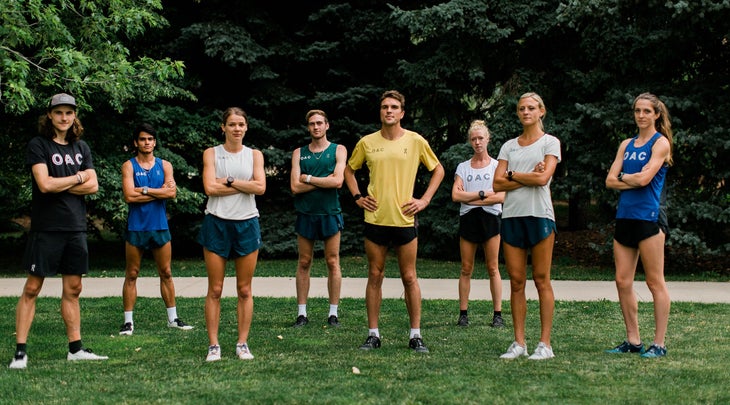
“I was not expecting a group like this to pop up, especially in the middle of Covid,” Falland says. “Given the climate of the sport in general, there was a lot of unknown and a lot of companies were dropping athletes or just not signing new ones. But On and Dathan put a lot of faith in us and found the right group of people to develop the right culture. It’s beyond what I could have asked for.”
In addition to long-term athlete contracts through the next Olympic cycle, the athletes have also benefited from the ancillary budget that Ritzenhein can use for travel, training camps, massage therapy and other things the team needs.
“We’ve tried to create contracts for them so they could eliminate some of the stressors of living in Boulder and adapting to the post-collegiate world so they could focus on training and racing,” Ritzenhein says. “It creates a super-supportive team environment where everything is taken care of. When you leave the nest of a college program and turn pro, you have to find a lot of things for yourself — a massage therapist, a strength coach and things like that. But there’s a lot more than the actual financial investment in the athletes. There’s an actual investment in what they’re doing on a day-to-day basis.”
4) Partners in the cause
A somewhat unexpected bit of support also came from a partnership with Roll Recovery, a Boulder-based brand of innovative massage and recovery tools for runners. When the pandemic struck and Roll Recovery founders Jeremy and Adriana Nelson had to keep their small workforce at home, they re-envisioned a part of their offices in the Gunbarrel neighborhood at the north end of Boulder into a OAC gym.
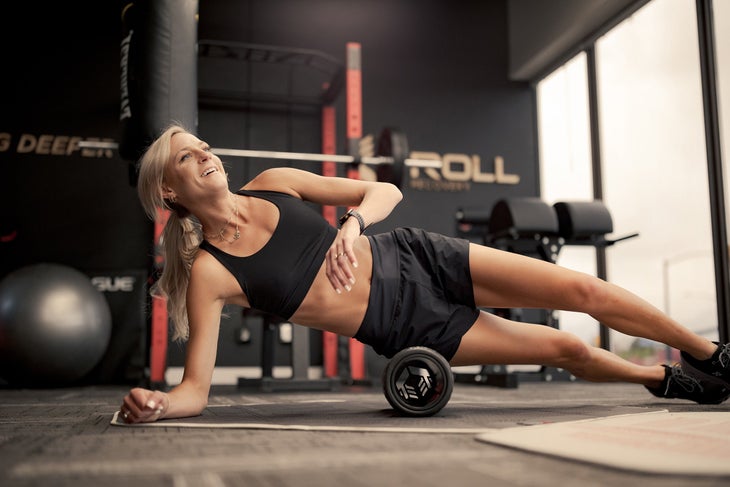
Through a partnership with On, the Nelsons and their colleagues shifted an upstairs sales and marketing office room that housed four workspaces into the lower-level warehouse. In its place, Roll Recovery created a small but functional custom-designed gym for the OAC athletes to do strength training, stretching and mobility work and to get massages. It includes free weights, weight machines, treadmills, stretching tools and even hurdles.
Over the past six months, it’s become a key facility for the young team and helped it streamline its weekly training regimen, especially in a time when most private gyms and public rec centers in Boulder were closed or had very limited access. Aside from helping the athletes save time and money, it also helped foster the team’s cohesive vibe.
“It’s really provided us with the right space, in the right area, and something that is really special and different than what a lot of other groups have,” Ritzenhein says. “It’s like a home base, which I think is important, but I think it’s also helped us develop a team bond and atmosphere. …The athletes might not even realize how important it is, but I know, based on my experience, that it’s been a key resource for us.”
5) Purposeful consistency
With Ritzenhein’s calm leadership and the team chemistry helping ease other stresses, the OAC was able to focus on consistent training. While most pro runners in Boulder train on the dirt roads and smooth trails near town, Ritzenhein made it a point to have the OAC train at Niwot High School north of Boulder. Not only was it closer to his house, but it was away from the congestion of Boulder and the elite running “scene” common the tracks in Boulder.
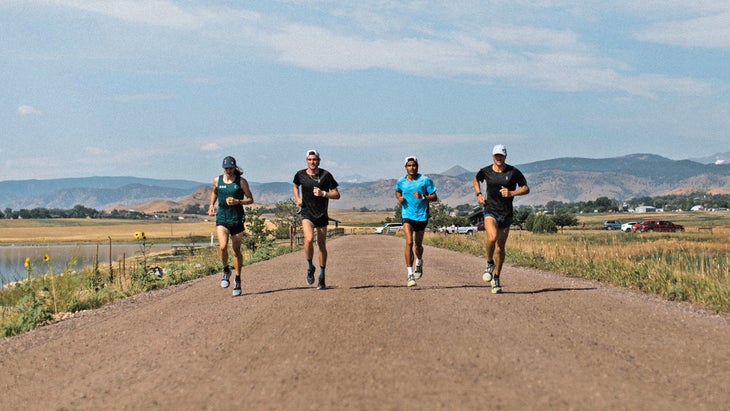
Aside from the buzz created by their initial mile time trials last summer, the OAC athletes generally kept a pretty low profile. Their social media presence was relatively modest, they weren’t flexing their egos and talking themselves up and they weren’t selling T-shirts as a side hustle. Instead, it was mostly about adjusting to the new program, running the miles, doing the workouts, resting, recovering and repeating it while waiting for opportunities to race.
“In some ways, I think the Covid situation helped us,” Ritzenhein says. “We could just focus on getting super fit and then when the right opportunities came, we were able to take them. It was a strange time, but we knew the only thing we could control is how fit we could get and whenever those events would happen, we’d just have to be ready.”
Ritzenhein has the unique experience of having trained under several of the best coaches of the current era, including Mark Wetmore and Heather Burroughs, Brad Hudson, Alberto Salazar and Kevin and Keith Hanson. He’s taken aspects of those approaches and has applied his own ideas based on what worked for him (which is especially important given that he dealt with numerous injuries) and, most importantly, what he believes each of his athletes specifically needs.
Still, Ritzenhein’s coaching approach is slightly different than what each of the athletes had been doing previously — considerably different for some. Generally speaking, there have been a lot of double-session days, great intensity in workouts, loads of recovery and a lot of strength, mobility and recovery work. And occasionally, he’s coupled hard workouts immediately after races.
“I ran 3:37 for the 1,500 in Portland (on June 3), which was a new PR for me, then we immediately drove to a different track and did a 3-mile tempo followed by 4×800 at 2:02 down to 1:58,” Klecker says. “So I had just run the race of my life, but then to do that great workout with that fatigue, it lets me know that I’ll be able to close a race very well. I have learned so much from him and improved so much in such a short period of time that maybe it’s like I’ve gained four years of knowledge just in the past year.”


